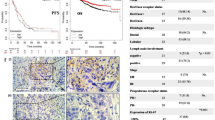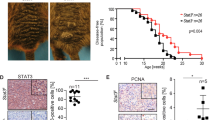Abstract
Cathepsin L, a cysteine protease, is overexpressed in human tumor cells and plays a major role in melanoma progression. Our aim was herein to identify molecular mechanisms, which contribute to its overexpression. We found that cathepsin L protein expression correlated with mRNA level in tumor cells. Therefore, we focused on mechanisms involved in cathepsin L mRNA regulation. CpG island was localized in the 5′ region of cathepsin L gene that encompassed regulatory regions identified as essential for promoter activity. CpG dinucleotides, not methylated in any melanoma cells analysed, were methylated in a B lymphoma cell line, which poorly express cathepsin L. Our data demonstrate that in lymphoma cells, cathepsin L silencing was methylation-dependent. Furthermore, gene amplification was involved in cathepsin L overexpression in one melanoma cell line, while transcriptional mechanisms but not mRNA stability are responsible of cathepsin L overexpression in others melanoma cells. In addition, NF-Y, Sp1, Sp2 and Sp3 transcription factors, essential to basal cathepsin L transcription, are not directly involved in overexpression. Thus, our data provides the first demonstration that cathepsin L expression in tumor cells is under the control of distinct molecular mechanisms.
This is a preview of subscription content, access via your institution
Access options
Subscribe to this journal
Receive 50 print issues and online access
$259.00 per year
only $5.18 per issue
Buy this article
- Purchase on Springer Link
- Instant access to full article PDF
Prices may be subject to local taxes which are calculated during checkout







Similar content being viewed by others
References
Abdollahi A, Getts LA, Sonoda G, Miller PD, Taguchi T, Godwin AK et al. (1999). J Soc Gynecol Investigat 6: 32–40.
Agirre X, Vizmanos JL, Calasanz MJ, Garcia-Delgado M, Larrayoz MJ, Novo FJ . (2003). Oncogene 22: 1070–1072.
Amuthan G, Biswas G, Zhang SY, Klein-Szanto A, Vijayasarathy C, Avadhani NG . (2001). EMBO J 20: 1910–1920.
Barel M, Fiandino A, Lyamani F, Frade R . (1989). Proc Natl Acad Sci USA 86: 10054–10058.
Charron M, DeCerbo JN, Wright WW . (2003). Biol Reprod 68: 1649–1656.
Chauhan SS, Popescu NC, Ray D, Fleischmann R, Gottesman MM, Troen BR . (1993). J Biol Chem 268: 1039–1045.
Frade R, Balbo M, Barel M . (2000). Cancer Res 60: 6585–6589.
Frade R, Rodrigues-Lima F, Huang S, Xie K, Guillaume N, Bar-Eli M . (1998). Cancer Res 58: 2733–2736.
Frade R . (1999). Immunopharmacology 42: 39–45.
Gardiner-Garden M, Frommer M . (1987). J Mol Biol 196: 261–282.
Grzybowska EA, Wilczynska A, Siedlecki JA . (2001). Biochem Biophys Res Commun 288: 291–295.
Guillaume-Rousselet N, Jean D, Frade R . (2002). Biochem J 367: 219–227.
Huang S, Mills L, Mian B, Tellez C, McCarty M, Yang XD et al. (2002). Am J Pathol 161: 125–134.
Hughes SJ, Glover TW, Zhu XX, Kuick R, Thoraval D, Orringer MB et al. (1998). Proc Natl Acad Sci USA 95: 12410–12415.
Ishidoh K, Taniguchi S, Kominami E . (1997). Biochem Biophys Res Comm 238: 665–669.
Jean D, Bar-Eli M, Huang S, Xie K, Rodrigues-Lima F, Hermann J, Frade R . (1996). Cancer Res 56: 254–258.
Jean D, Guillaume N, Frade R . (2002). Biochem J 361: 173–184.
Jean D, Hermann J, Rodrigues-Lima F, Barel M, Balbo M, Frade R . (1995). Biochem J 312: 961–969.
Jean D, Rodrigues-Lima F, Cassinat B, Hermann J, Cabane J, Frade R . (1997). Immunol Lett 58: 107–112.
Kamboj RC, Pal S, Raghav N, Singh H . (1993). Biochimie 75: 873–878.
Kawada A, Hara K, Kominami E, Hiruma M, Noguchi H, Ishibashi A . (1997). Arch Dermatol Res 289: 87–93.
Kirschke H, Eerola R, Hopsu-Havu VK, Bromme D, Vuorio E . (2000). Eur J Cancer 36: 787–795.
Krueger S, Kellner U, Buehling F, Roessner A . (2001). Cancer Gene Ther 8: 522–528.
Levicar N, Dewey RA, Daley E, Bates TE, Davies D, Kos J et al. (2003). Cancer Gene Ther 10: 141–151.
Luca MR, Bar-Eli M . (1998). Histol Histopathol 13: 1225–1231.
Malone CS, Miner MD, Doerr JR, Jackson JP, Jacobsen SE, Wall R et al. (2001). Proc Natl Acad Sci USA 98: 10404–10409.
Mao X, Hamoudi RA . (2000). Cancer Genet Cytogenet 122: 87–92.
Ohashi K, Naruto M, Nakaki T, Sano E . (2003). Biochim Biophys Acta 1649: 30–39.
Pesole G, Liuni S . (1999). Trends Genet 15: 378.
Rousselet N, Mills L, Jean D, Tellez C, Bar-Eli M, Frade R . (2004). Cancer Res 64: 146–151.
Sriraman V, Richards JS . (2004). Endocrinology 145: 582–591.
Suske G . (1999). Gene 238: 291–300.
Turk V, Turk B, Guncar G, Turk D, Kos J . (2002). Adv Enzyme Regul 42: 285–303.
Acknowledgements
This work was supported by INSERM, Ligue Contre le Cancer (Comité Ile-de-France et Comité de l'Essonne) and Association de Recherche contre le Cancer (ARC, Villejuif).
Author information
Authors and Affiliations
Corresponding author
Rights and permissions
About this article
Cite this article
Jean, D., Rousselet, N. & Frade, R. Expression of cathepsin L in human tumor cells is under the control of distinct regulatory mechanisms. Oncogene 25, 1474–1484 (2006). https://doi.org/10.1038/sj.onc.1209196
Received:
Revised:
Accepted:
Published:
Issue Date:
DOI: https://doi.org/10.1038/sj.onc.1209196
Keywords
This article is cited by
-
Cathepsin L-mediated resistance of paclitaxel and cisplatin is mediated by distinct regulatory mechanisms
Journal of Experimental & Clinical Cancer Research (2019)
-
The heparanase system and tumor metastasis: is heparanase the seed and soil?
Cancer and Metastasis Reviews (2011)
-
Cathepsin L increased level upon Ras mutants expression: the role of p38 and p44/42 MAPK signaling pathways
Molecular and Cellular Biochemistry (2010)
-
Intratumoral gene delivery of anti-cathepsin L single-chain variable fragment by lentiviral vector inhibits tumor progression induced by human melanoma cells
Cancer Gene Therapy (2008)
-
multifunctional enzymes in cancer
Nature Reviews Cancer (2006)



